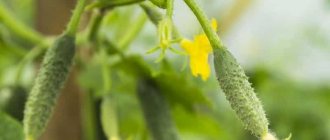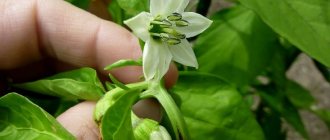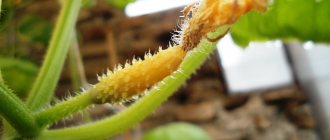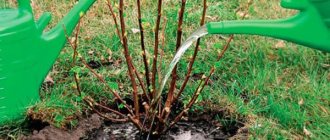Author of the article: Svetlana Galitsina | Updated: 11-01-2022
Hanging folder Stamm
180 ₽ More details
Set of hanging folders Brauberg, Foolscap, 231794, yellow, 80 sheets, 10 pcs.
935 ₽ More details
Serpentines
Very often, vegetable growers are faced with such a problem as the absence of ovaries on eggplants. It happens that plants develop well, bloom profusely, but the fruits do not set, and over time the empty flowers fall off. It is fair to note that this situation most often arises when growing eggplants in a greenhouse. Why does this happen, and what to do about it? Generally speaking, the reason is a violation of agricultural technology. There are several ways to solve this problem, but first you need to determine the reason why there is no ovary, and there are quite a lot of them.
Reasons for the absence of ovaries
Eggplants are whimsical plants. Wherever they grow, in a greenhouse or in a garden bed, they need to create optimal conditions for the development and growth of fruits. If the rules of agricultural technology are neglected, there will be few flowers and ovaries, and it may even happen that the ovary falls off while still a flower.
The reasons why a plant blooms but does not set fruit may be the following:
Temperature violation
Eggplant is very picky about air temperature. On average, for normal growth, it should be 25-27 °C. If this indicator drops to 15-18 °C, the plant will simply freeze (stop developing). And if this happens during the flowering period, then the ovary most likely will not form, and the barren flower will dry out and fall off. The same situation occurs when the temperature is too high - at 32 °C and above, the flowers are not pollinated and the eggplants do not set.
Unsuitable soil
Eggplants grow well in fertile, well-drained soil with neutral acidity. If the soil in a greenhouse or garden is too dense, acidic and does not warm up well - this happens with clay and podzolic soils, fruit formation may not occur at all. Conduct a soil analysis - perhaps it is simply unsuitable for growing eggplants.
Insufficient or improper watering
It is known that eggplants prefer moist soil. Their flowering, formation of ovaries, and, accordingly, fruiting largely depend on abundant and regular watering. It is important to constantly maintain optimal (moderate) humidity, especially in a greenhouse, since insufficient humidity disrupts plant nutrition, which causes a delay in the formation of buds and fruits. If the humidity is too high (water stagnation), the access of oxygen to the root system is reduced, which is why the development of the plant is also disrupted.
Fertilizers
Sometimes vegetable growers, in an effort to get an earlier and more abundant harvest, add a lot of fertilizers, both mineral and organic, to the soil. In response to this, eggplants begin to actively grow green mass, but at the same time, all the strength of the plant is directed towards the formation of a bush - there are practically no flower stalks or very few, and those that have formed dry out and crumble.
Excess nitrogen
In general, eggplant is very responsive to any fertilizer, but nitrogen is one of those elements that is applied at a strictly defined time, usually in early spring. If nitrogen fertilizer is applied already during the vegetative process, it will be very stressful for the plant, which will affect flowering and the number of ovaries.
Excess pollen
Fruiting of most eggplant varieties occurs through self-pollination. This is very convenient when growing vegetables in a greenhouse, but there is also some negative aspect.
Flowering eggplants regularly produce large amounts of pollen, which becomes heavy as it accumulates and sometimes even sticks together. In this case, it cannot be transferred to other plants, which is why self-pollination does not occur.
Provide the plant with enough light
Eggplant is very light-loving. Therefore, the greenhouse must allow sufficient sunlight to pass through. Otherwise, the development of the plant will slow down. The ovaries will appear too late. Or it may not appear at all.
Problems with light can be caused not only by a cloudy greenhouse cover, but also by a lack of sunny days and cloudy weather. In this case, you can try installing LED seedling lamps above the plantings. One costs about 1,000–1,500 rubles and is capable of covering 3–5 adult plants.
Remove dead parts of the plant
The lower leaves of eggplants often turn yellow and then die. Under no circumstances should you leave them. The dead parts begin to rot. Rotting can spread to the pedicels and cause flowers to drop. It is quite clear that fruits will not appear in their place.
It is also necessary to remove any remaining whisk. For the same reason - it can begin to rot, and with it the peduncle.
Choose the right variety
In the conditions of central Russia, it is best to use early varieties of eggplant. The logic here is very simple - late varieties may simply not ripen if the beginning of summer is cloudy and cold. Therefore, the optimal choice is early ripening eggplants.
How to fix problems
Sometimes vegetable growers, faced with problems in growing eggplants, resort to a variety of drugs and means, trying to deceive the plant and force it to grow fruits in an unnatural way.
Such spraying preparations as “Bud”, “Ovary” and their analogues contain gibberellin, a phytohormone that regulates and stimulates plant growth. Under ideal conditions, this substance is produced independently in eggplants, but if these conditions are violated, its formation is disrupted.
Spraying with stimulating drugs is quite effective, but not the most correct way to solve the problem. It is much more important to create suitable conditions for growing vegetables and eliminate the factors that lead to the fact that the ovaries do not form:
- if the reason is excess nitrogen, it is necessary to add a potassium-phosphorus mixture or ash to the soil - these substances will slightly soften the activity of nitrogen;
- peduncles on self-pollinating eggplants in a greenhouse must be shaken regularly, but very carefully - this will save the pollen from drying out and increase pollination;
- if the eggplants are not self-pollinating, then the reason why a barren flower is formed may be the lack of pollination - in this case, you need to pollinate the flowers on the eggplants manually using a brush;
- it is necessary to control and regulate the air temperature - modern greenhouses maintain a constant temperature at night, but during the day, due to the large amount of daylight, the temperature in the greenhouse can increase significantly;
- special attention should be paid to watering the eggplant, especially if the vegetables grow in a greenhouse - watering is carried out at the root in a zone of 30-40 cm around the bush, you need to water abundantly, but not too often and as needed (frequent watering contributes to stagnation of moisture), water for watering should be a little warm;
Good fruiting of eggplants is impossible without regular feeding. Vegetables are fed several times during the season. The first feeding is carried out 2 weeks after planting the seedlings in the ground - both mineral mixtures and organic matter (mullein solution) are appropriate here. Next, the eggplants need to be fed during the period of bud formation and flowering. The next feeding is carried out during the beginning of fruiting - phosphorus and potassium fertilizers are used (potassium is necessary for the good taste of eggplant).
What to do if eggplants do not set well
It is necessary to carefully choose the variety. As a rule, eggplants are grown in a greenhouse. For such conditions, the most suitable varieties are:
- Alekseevsky;
- Philemon;
- Hippopotamus;
- Purple miracle;
- Bibo (hybrid).
Before planting, the seeds must be checked. To do this, dissolve a tablespoon of salt in one liter of water and immerse them for at least half an hour. If any seeds float to the surface, you should not use them. When seedlings begin to be grown from them, the eggplants bloom well, but do not set even in a polycarbonate greenhouse.
Another important measure is site preparation. The soil should be fertile and loose. Therefore, several months before planting, the soil is dug up and fertilized with organic matter (compost, humus) in an amount of 7-10 kg per 1 m2. If the soil is dense, sand or sawdust should be added to it - up to 1 kg or more (for the same area).
If necessary, pH is measured. If it is less than 6.0, it is necessary to add dolomite flour or wood ash (200-300 g per square meter). If the soil, on the contrary, is alkaline, it is acidified, for example, with a 9% vinegar solution (100 ml per 10 liters of water per 1 m2).
Plants are provided with normal watering. When an eggplant doesn't set, it may be lacking moisture. Therefore, you should give water at least twice a week, making sure that the soil always remains slightly moist. The liquid is first left to settle at room temperature.
It is also necessary to provide normal nutrition. Fertilizers are applied at least three times per season. Immediately after transplantation, they are fed with nitrogen compounds, for example, ammonium nitrate - 20-25 g per 10 liters. During the formation of buds, superphosphate (40 g per 10 l) and potassium salt (25 g per 10 l) are given. You can also use complex fertilizers, for example, Kemira Lux.
Regular application of fertilizers ensures good yields
Another important point is preventive treatments against insects and pests. To do this, you can use folk remedies, for example, an infusion of wood ash, herbs (wormwood, celandine, dandelion). But if a lot of Colorado potato beetles and other insects are found, it is worth using insecticides:
- "Tanrek";
- "Fury";
- "Aktara";
- "Kinmiks" and others.
To prevent late blight and other fungal infections, fungicides are used:
- "Maksim";
- "Ordan";
- "Skor";
- "Bordeaux mixture" and others.
Treatment should be carried out in the absence of rain and strong wind. It is better to do this late in the evening or early in the morning.
Reasons for falling buds
The falling of buds on eggplants even before flowering is the most unpleasant and quite common problem. The reasons why this happens are the most classic:
- a sharp change in temperature - if the temperature conditions in the greenhouse are not self-regulating, it is necessary to control the temperature yourself: when it becomes hot to open, so that the eggplants do not suffocate and bake, the greenhouse must be carefully closed at night;
- drying out of the soil or even a slight lack of moisture can also cause buds to fall off on eggplants;
- lack of microelements (most often boron) is the most common reason why buds or empty flowers on eggplants fall off - the problem can be solved by adding a solution of boric acid in a proportion of 10 g/bucket of water (eggplants are sprayed with the solution).
The falling off of already faded flower stalks indicates that they simply have not become dusty. It should be clarified that of all the flowers that bloom on eggplants, only 60% are pollinated and bear fruit, the rest can bloom for a long time and beautifully, but will dry out without being pollinated.
Preventive measures
To help the plant form high-quality and strong ovaries, experts recommend taking a number of preventive measures:
- prepare the soil thoroughly: apply fertilizer, loosen, moisten;
- select only high-quality seed material;
- carry out regular ventilation of the greenhouse;
- carry out regular shaping of the bush: remove dry, dead, weak and damaged stems, poor-quality ovaries, dry leaves;
- systematically shake the pollen on the flowers to increase the percentage of pollination.
Eggplants, although they are a whimsical and capricious plant, with proper adherence to agricultural technology and the organization of comfortable conditions, can please gardeners with stable and abundant harvests. The main thing is to remember that the culture requires nutritious soil, stable moisture, high-quality fertilizing and regular human care.
Large amount of pollen
Eggplants are plants that bear fruit through self-pollination. Moreover, their pollen is so heavy that it can only be transported over a distance of up to a meter. Therefore, to form a normal number of ovaries, you should shake the plants in the morning. Of course, this must be done very carefully.
It is worth considering that even with hand pollination, eggplants can also lose a significant part of their ovaries. This happens due to hot or cold temperatures, since plants are very picky about weather conditions. The optimal temperature for growing eggplants is from 25 C to 35 C. Prolonged rainy weather can also negatively affect the condition of the plants; to avoid this, it is better to grow the crop in a greenhouse. The negative effects of temperature conditions can be reduced by treating with Novosil and Immunodeficiency drugs.
Why do eggplant flowers fall off? Artificial pollination
Reviews:
Tatiana Korsun
writes: Natalya, hello! I have another problem: the planted eggplant seedlings were hit by hail, the top leaves curl up and the bottom ones are damaged by the hail. Is it possible to save the plants?
Tatiana Sapegina
writes: Natalya, hello. Help me please. After planting, some of my eggplants were burned, frozen, and the lower leaves fell off (in some, right down to the fork). The shoots themselves survived, the new upper ones are growing back beautifully, but now stepsons have appeared in the places that fell (in some places they are just stems, in others they are still buds).... What should I do? Either remove them, leaving trunks bald up to the fork, or remove them, leaving one leaf at a time... or they will replace fallen leaves... I just don’t know what to do now. Thank you very much in advance!!!
Tatiana Korsun
writes: Natalya, hello! I have another problem: the planted eggplant seedlings were hit by hail, the top leaves curl up and the bottom ones are damaged by the hail. Is it possible to save the plants?
Tatiana Sapegina
writes: Natalya, hello. Help me please. After planting, some of my eggplants were burned, frozen, and the lower leaves fell off (in some, right down to the fork). The shoots themselves survived, the new upper ones are growing back beautifully, but now stepsons have appeared in the places that fell (in some places they are just stems, in others they are still buds).... What should I do? Either remove them, leaving trunks bald up to the fork, or remove them, leaving one leaf at a time... or they will replace fallen leaves... I just don’t know what to do now. Thank you very much in advance!!!
Not all gardeners can grow excellent eggplants on their own plot: for some the plants do not bloom, for others the ovaries do not form, for others the formation of ovaries begins exclusively at the end of summer - the beginning of autumn, while others can only collect unripe fruits. What is this connected with?











